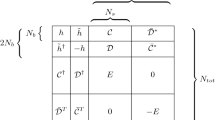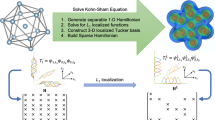Abstract
In the present work, we initiate a program that explores modewise Johnson–Lindenstrauss embeddings (JLEs) as a tool to reduce the computational cost and memory requirements of (nuclear) many-body methods. These embeddings are randomized projections of high-dimensional data tensors onto low-dimensional subspaces that preserve structural features like norms and inner products. An appealing feature of randomized embedding techniques is that they allow for the oblivious and incremental compression of large tensors, e.g., the nuclear Hamiltonian or wave functions amplitudes, into significantly smaller random sketches that still allow for the accurate calculation of ground-state energies and other observables. In particular, the oblivious nature of randomized JLE techniques makes it possible to compress a tensor without knowing in advance exactly what observables one might want to approximate at a later time. This opens the door for the use of tensors that are much too large to store in memory, e.g., untruncated three-nucleon forces in current approaches, or complete two- plus three-nucleon Hamiltonians in large, symmetry-unrestricted bases. Such compressed Hamiltonians can be stored and used later on with relative ease. As a first step, we perform a detailed analysis of a JLE’s impact on the second-order Many-Body Perturbation Theory (MBPT) corrections for nuclear ground-state observables like the energy and the radius, noting that these will be the dominant corrections in a well-behaved perturbative expansion, and highly important implicit contributions even in nonperturbative approaches. Numerical experiments for a wide range of closed-shell nuclei, model spaces and state-of-the-art nuclear interactions demonstrate the validity and potential of the proposed approach: We can compress nuclear Hamiltonians hundred- to thousandfold while only incurring mean relative errors of 1% or less in ground-state observables. Importantly, we show that JLEs capture the relevant physical information contained in the highly structured Hamiltonian tensor despite their random characteristics. In addition to the significant storage savings, the achieved compressions imply multiple order-of-magnitude reductions in computational effort when the compressed Hamiltonians are used in higher-order MBPT or nonperturbative many-body methods.












Similar content being viewed by others
Data Availability Statement
This manuscript has associated data in a data repository. [Authors’ comment: The simulation codes and data for \({}^{132}\textrm{Sn}\) obtained with the EM1.8/2.0 interaction in an \(e_\text {max}=6\) basis can be accessed in a Github repository at https://github.com/azarerepo/JL4MBPT. Data for other nuclei and basis sizes are available from the authors upon request.]
Notes
We will use the notation \([n]\equiv \{1,\dots ,n\}\) throughout the paper.
For information on mode-j fibers and unfoldings, and mode products in tensors, see [40].
The contraction explicitly accounts for the contribution of the nonvanishing RHS of the fundamental anticommutator Eq. (10) so that we only need to track signs when we permute operators within a normal-ordered string.
We denote the radial quantum number with a \(\nu \) instead of the usual n to avoid confusion with the occupation numbers. Individual single-particle states carry the projection \(m_p\) of \(j_p\) as quantum numbers in addition to the tuple p.
We suppress the exponent of the operator to reduce clutter in subsequent expressions.
Depending on the storage format for the sparse Hamiltonian tensor, we may face significant overhead: A coordinate-based format, for instance, would have a fivefold overlap because it needs to store four indices for each element in addition to the element’s value.
References
B.R. Barrett, P. Navrátil, J.P. Vary, Prog. Part. Nucl. Phys. 69, 131 (2013). https://doi.org/10.1016/j.ppnp.2012.10.003
P. Navrátil, S. Quaglioni, G. Hupin, C. Romero-Redondo, A. Calci, Phys. Scripta 91(5), 053002 (2016). https://doi.org/10.1088/0031-8949/91/5/053002
C. Yang, H.M. Aktulga, P. Maris, E. Ng, J.P. Vary, in Proceedings of International Conference ‘Nuclear Theory in the Supercomputing Era — 2013’ (NTSE-2013), Ames, 2013, ed. by A.M. Shirokov, A.I. Mazur p. 272
H. Hergert, Front. Phys. 8, 379 (2020). https://doi.org/10.3389/fphy.2020.00379
A.B. Balantekin, J. Carlson, D.J. Dean, G.M. Fuller, R.J. Furnstahl, M. Hjorth-Jensen, R.V.F. Janssens, B.A. Li, W. Nazarewicz, F.M. Nunes, W.E. Ormand, S. Reddy, B.M. Sherrill, Mod. Phys. Lett. A 29(11), 1430010 (2014). https://doi.org/10.1142/S0217732314300109
H. Hergert, S.K. Bogner, T.D. Morris, A. Schwenk, K. Tsukiyama, Physics Reports 621, 165 (2016). https://doi.org/10.1016/j.physrep.2015.12.007
H. Hergert, Phys. Scripta 92(2), 023002 (2017). http://stacks.iop.org/1402-4896/92/i=2/a=023002
S.R. Stroberg, H. Hergert, S.K. Bogner, J.D. Holt, Ann. Rev. Nucl. Part. Sci. 69(1), 307 (2019). https://doi.org/10.1146/annurev-nucl-101917-021120
I. Shavitt, R.J. Bartlett, Many-Body Methods in Chemistry and Physics: MBPT and Coupled-Cluster Theory (Cambridge University Press, Cambridge, 2009)
G. Hagen, T. Papenbrock, M. Hjorth-Jensen, D.J. Dean, Rept. Prog. Phys. 77(9), 096302 (2014). http://stacks.iop.org/0034-4885/77/i=9/a=096302
V. Somà, Front. Phys. 8, 340 (2020). https://doi.org/10.3389/fphy.2020.00340
C. Barbieri, T. Duguet, V. Somà, Phys. Rev. C 105, 044330 (2022). https://doi.org/10.1103/PhysRevC.105.044330
A. Rios, Front. Phys. 8, 387 (2020). https://doi.org/10.3389/fphy.2020.00387
S.R. Stroberg, J.D. Holt, A. Schwenk, J. Simonis, Phys. Rev. Lett. 126, 022501 (2021). https://doi.org/10.1103/PhysRevLett.126.022501
B. Hu, W. Jiang, T. Miyagi, Z. Sun, A. Ekström, C. Forssén, G. Hagen, J.D. Holt, T. Papenbrock, S.R. Stroberg, I. Vernon, Nat. Phys. (2022). https://doi.org/10.1038/s41567-022-01715-8
P. Navrátil, G.P. Kamuntavicius, B.R. Barrett, Phys. Rev. C 61, 044001 (2000)
A. Nogga, P. Navrátil, B.R. Barrett, J.P. Vary, Phys. Rev. C 73, 064002 (2006). https://doi.org/10.1103/PhysRevC.73.064002
A. Nogga, H. Kamada, W. Gloeckle, Phys. Rev. Lett. 85, 944 (2000)
R. Schutski, J. Zhao, T.M. Henderson, G.E. Scuseria, J. Chem. Phys. 147(18), 184113 (2017). https://doi.org/10.1063/1.4996988
R.M. Parrish, Y. Zhao, E.G. Hohenstein, T.J. Martínez, J. Chem. Phys. 150(16), 164118 (2019). https://doi.org/10.1063/1.5092505
E.G. Hohenstein, Y. Zhao, R.M. Parrish, T.J. Martínez, J. Chem. Phys. 151(16), 164121 (2019). https://doi.org/10.1063/1.5121867
E.G. Hohenstein, B.S. Fales, R.M. Parrish, T.J. Martínez, J. Chem. Phys. 156(5), 054102 (2022). https://doi.org/10.1063/5.0077770
M. Lesiuk, J. Comput. Chem. 40(12), 1319 (2019). https://doi.org/10.1002/jcc.25788
M. Lesiuk, J. Chem. Theory Comput. 16(1), 453 (2020). https://doi.org/10.1021/acs.jctc.9b00985
M. Lesiuk, J. Chem. Theory Comput. 17(12), 7632 (2021). https://doi.org/10.1021/acs.jctc.1c00933
B. Zhu, R. Wirth, H. Hergert, Phys. Rev. C 104, 044002 (2021). https://doi.org/10.1103/PhysRevC.104.044002
A. Tichai, P. Arthuis, K. Hebeler, M. Heinz, J. Hoppe, A. Schwenk, Phys. Lett. B 821, 136623 (2021). https://doi.org/10.1016/j.physletb.2021.136623
A. Tichai, R. Schutski, G.E. Scuseria, T. Duguet, Phys. Rev. C 99, 034320 (2019). https://doi.org/10.1103/PhysRevC.99.034320
A. Tichai, P. Arthuis, K. Hebeler, M. Heinz, J. Hoppe, A. Schwenk, L. Zurek, Phys. Rev. C 106, 024320 (2022). https://doi.org/10.1103/PhysRevC.106.024320
B. Nagy, F. Jensen, Rev. Comput. Chem. 30, 93 (2017). https://doi.org/10.1002/9781119356059.ch3
A. Tichai, J. Müller, K. Vobig, R. Roth, Phys. Rev. C 99, 034321 (2019). https://doi.org/10.1103/PhysRevC.99.034321
J. Hoppe, A. Tichai, M. Heinz, K. Hebeler, A. Schwenk, Phys. Rev. C 103, 014321 (2021). https://doi.org/10.1103/PhysRevC.103.014321
S.J. Novario, G. Hagen, G.R. Jansen, T. Papenbrock, Phys. Rev. C 102, 051303 (2020). https://doi.org/10.1103/PhysRevC.102.051303
W.B. Johnson, J. Lindenstrauss, in Conference in modern analysis and probability, ed. by R. Beals, A. Beck, A.a.o. Bellow. no. 26 in Contemporary Mathematics, 1984 (Conn., New Haven, 1982), p. 189. https://doi.org/10.1090/conm/026/737400
N. Halko, P. Martinsson, J. Tropp, SIAM Rev. 53(2), 217 (2011). https://doi.org/10.1137/090771806
M.W. Mahoney, Found. Trends Mach. Learn. 3(2), 123 (2011). https://doi.org/10.1561/2200000035
D.P. Woodruff, Found. Trends Theor. Comput. Sci. 10(1–2), 1 (2014). https://doi.org/10.1561/0400000060
C. Battaglino, G. Ballard, T.G. Kolda, SIAM J. Matrix Anal. Appl. 39(2), 876 (2018). https://doi.org/10.1137/17M1112303
Y. Sun, Y. Guo, C. Luo, J.A. Tropp, M. Udell, SIAM J. Math. Data Sci. (SIMODS) 2(4), 1123 (2020). https://doi.org/10.1137/19M1257718
T.G. Kolda, B.W. Bader, SIAM Rev. 51(3), 455 (2009). https://doi.org/10.1137/07070111X
M.A. Iwen, D. Needell, E. Rebrova, A. Zare, SIAM J. Matrix Anal. Appl. 42(1), 376 (2021). https://doi.org/10.1137/19M1308116
D. Achlioptas, J. Comput. Syst. Sci. 66(4), 671 (2003)
S. Dasgupta, A. Gupta, Random Struct. Algorithms 22(1), 60 (2003)
J. Håstad, J. Algorithms 11(4), 644 (1990). https://doi.org/10.1016/0196-6774(90)90014-6
R. Vershynin, High-Dimensional Probability: An Introduction with Applications in Data Science. Cambridge Series in Statistical and Probabilistic Mathematics (Cambridge University Press, 2018)
J. Langhammer, R. Roth, C. Stumpf, Phys. Rev. C 86, 054315 (2012). https://doi.org/10.1103/PhysRevC.86.054315
A. Tichai, J. Langhammer, S. Binder, R. Roth, Phys. Lett. B 756, 283 (2016). https://doi.org/10.1016/j.physletb.2016.03.029
A. Tichai, R. Roth, T. Duguet, Front. Phys. 8, 164 (2020). https://doi.org/10.3389/fphy.2020.00164
W. Kutzelnigg, D. Mukherjee, J. Chem. Phys. 107(2), 432 (1997). https://doi.org/10.1063/1.474405
S.B. Khadkikar, V.B. Kamble, Nucl. Phys. A 225, 352 (1974)
H. Hergert, R. Roth, Phys. Lett. B 682, 27 (2009). https://doi.org/10.1016/j.physletb.2009.10.100
G. Hagen, T. Papenbrock, D.J. Dean, A. Schwenk, A. Nogga, M. Włoch, P. Piecuch, Phys. Rev. C 76, 034302 (2007). https://doi.org/10.1103/PhysRevC.76.034302
R. Roth, S. Binder, K. Vobig, A. Calci, J. Langhammer, P. Navrátil, Phys. Rev. Lett. 109, 052501 (2012). https://doi.org/10.1103/PhysRevLett.109.052501
A. Tichai, R. Wirth, J. Ripoche, T. Duguet, Eur. Phys. J. A 56(10), 272 (2020). https://doi.org/10.1140/epja/s10050-020-00233-6
K. Hebeler, S.K. Bogner, R.J. Furnstahl, A. Nogga, A. Schwenk, Phys. Rev. C 83, 031301 (2011). https://doi.org/10.1103/PhysRevC.83.031301
A. Nogga, S.K. Bogner, A. Schwenk, Phys. Rev. C 70, 061002 (2004). https://doi.org/10.1103/PhysRevC.70.061002
S.K. Bogner, R.J. Furnstahl, A. Schwenk, Prog. Part. Nucl. Phys. 65, 94 (2010). https://doi.org/10.1016/j.ppnp.2010.03.001
T. Miyagi, S.R. Stroberg, P. Navrátil, K. Hebeler, J.D. Holt, Phys. Rev. C 105, 014302 (2022). https://doi.org/10.1103/PhysRevC.105.014302
K. Hebeler, V. Durant, J. Hoppe, M. Heinz, A. Schwenk, J. Simonis, A. Tichai, Phys. Rev. C 107, 024310 (2023), https://doi.org/10.1103/PhysRevC.107.024310
E. Gebrerufael, A. Calci, R. Roth, Phys. Rev. C 93, 031301 (2016). https://doi.org/10.1103/PhysRevC.93.031301
F. Krahmer, R. Ward, SIAM J. Math. Anal. 43(3), 1269 (2011)
J.M. Yao, Symmetry Restoration Methods (Springer Nature Singapore, Singapore, 2022), pp. 1–36. https://doi.org/10.1007/978-981-15-8818-1_18-1
J.M. Yao, B. Bally, J. Engel, R. Wirth, T.R. Rodríguez, H. Hergert, Phys. Rev. Lett. 124, 232501 (2020). https://doi.org/10.1103/PhysRevLett.124.232501
M. Frosini, T. Duguet, J.P. Ebran, V. Somà, Eur. Phys. J. A 58(4) (2022). https://doi.org/10.1140/epja/s10050-022-00692-z
M. Frosini, T. Duguet, J.P. Ebran, B. Bally, H. Hergert, T.R. Rodríguez, R. Roth, J.M. Yao, V. Somà, Eur. Phys. J. A 58(4), 64 (2022). https://doi.org/10.1140/epja/s10050-022-00694-x
M. Frosini, T. Duguet, J.P. Ebran, B. Bally, T. Mongelli, T.R. Rodríguez, R. Roth, V. Somà, Eur. Phys. J. A 58(4) (2022). https://doi.org/10.1140/epja/s10050-022-00693-y
G. Hagen, S.J. Novario, Z.H. Sun, T. Papenbrock, G.R. Jansen, J.G. Lietz, T. Duguet, A. Tichai, Phys. Rev. C 105, 064311 (2022). https://doi.org/10.1103/PhysRevC.105.064311
Acknowledgements
C. A. Haselby and M. Iwen were supported in part by the National Science Foundation under Award No. DMS 2106472. H. Hergert and R. Wirth acknowledge support by the U.S. Department of Energy, Office of Science, Office of Nuclear Physics under Awards No. DE-SC0017887 and DE-SC0018083 (NUCLEI SciDAC-4 Collaboration.)
Author information
Authors and Affiliations
Corresponding author
Additional information
Communicated by V. Somá.
Appendix A: Additional results
Appendix A: Additional results
For completeness, we compile detailed results for energy corrections in additional nuclei in this appendix.
Contributions of each angular momentum channel to the mean relative error \(\overline{\varDelta E^{(2)}}/|E^{(2)}\) as a function of \(e_\text {max}\), for fixed compression \(c_\textrm{tot}\le 10^{-3}\). All calculations were performed with the EM1.8/2.0 interaction. Our favored two-stage JL embedding (RFD + RFD)real (cf. Sect. 5.2) was used for compression, and 200 trials were carried out
Figure 13 shows the angular-momentum channel breakdown of the mean relative error of \(E^{(2)}\) for different basis sizes in the nuclei \({}^{40,48}\textrm{Ca}\). The observed trends match what we found and discussed for \({}^{16}\textrm{O}\) and \({}^{132}\textrm{Sn}\) via Fig. 6.
Figure 14 extends the results for \(\overline{\varDelta E^{(2)}}(J)/|E^{(2)|}\) of Fig. 7 for nuclei beyond \({}^{16}\textrm{O}\). The mean relative errors grow exponentially as we decrease \(c_\textrm{tot}\) over a wide range, with some allowance for fluctuations due to the random sampling performed by the JLE (cf. Sect. 5.3.2).
Contributions of each angular momentum channel to the mean relative error \(\overline{\varDelta E^{(2)}}/|E^{(2)}|\) as a function of the compression \(c_\textrm{tot}\). Calculations were performed with the EM1.8/2.0 interaction in an \(e_\text {max}=14\) basis, and a two-stage JL embedding (RFD + RFD)real with \(c_2=0.2\) has been used. 200 trials were performed
Rights and permissions
Springer Nature or its licensor (e.g. a society or other partner) holds exclusive rights to this article under a publishing agreement with the author(s) or other rightsholder(s); author self-archiving of the accepted manuscript version of this article is solely governed by the terms of such publishing agreement and applicable law.
About this article
Cite this article
Zare, A., Wirth, R., Haselby, C.A. et al. Modewise Johnson–Lindenstrauss embeddings for nuclear many-body theory. Eur. Phys. J. A 59, 95 (2023). https://doi.org/10.1140/epja/s10050-023-00999-5
Received:
Accepted:
Published:
DOI: https://doi.org/10.1140/epja/s10050-023-00999-5






